Oxleas Wood is an ancient woodland just 25 minutes cycle ride away from Catford, so I don’t know why I haven’t been there before! I read that parts of it date back to the last ice age, 8000 years ago, so it should be good for those fungi which prefer a primeval habitat. However, I didn’t find any particularly unusual mushrooms on this occasion although I did see a rare tree species which Oxleas is known for – the Wild Service Tree.
There weren’t many larger mushrooms but lots of smaller Bonnets (Mycena). I recorded three but could have done several others. These three were Angels Bonnet, Common Bonnet, and Frosty Bonnet. I don’t get excited about the common small brownish Bonnet species but I haven’t recorded the pure white Frosty Bonnet before and it is quite attractive. Collybia aquosa is a Toughshank without a common name. (Should it be called Pale Toughshank?) I saw several Giant Funnels growing in pasture on the Hawkwood Estate last year so I was surprised to find one growing in a wood, but apparently this does happen. I haven’t recorded Firerug Inkcap before. It sometimes has a thing called an ozonium, which is a rug like structure on the growing surface, but I didn’t see one this time.
Yellow Fieldcap is striking in its yellowness and a mushroom I’ve not seen before. It’s surprising to find it here because I’ve read that Oxleas Meadow is managed like a traditional meadow to encourage wild meadow flowers. That involves cutting the grass to make hay and normally not fertilising the grass because the wild flowers compete more easily in less fertile soil (and some mushrooms prefer that too). However Yellow Fieldcap likes a rich habitat of rotting matter, grass cuttings, dung, etc. So why is it here, unless there have been animals grazing and therefore dung? I’ll be interested to see what else I find on another occasion. A proper unimproved (i.e. unfertilized) meadow should have several Waxcap species so I’ll be looking out for those.
1.
Angels Bonnet (
Mycena arcangeliana).
-
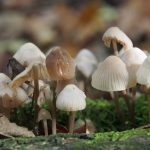
- 1. Angels Bonnet
-
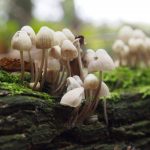
- 1. Angels Bonnet
-
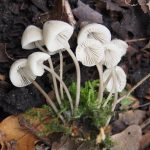
- 1. Angels Bonnet
-
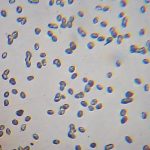
- 1. Angels Bonnet
Close groups along rotting mossy branch. Large groups. Cap up to 2cm. Stem Up to 4cm. Slight fungal smell. ID is very likely. Sporeprint White. Spores 7-8µ x 5-6µ.
2.
Common Bonnet (
Mycena galericulata).
-
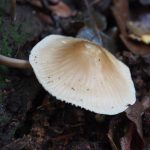
- 2. Common Bonnet
-
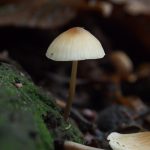
- 2. Common Bonnet
-
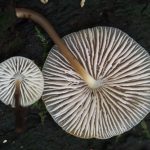
- 2. Common Bonnet
-
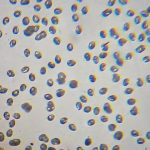
- 2. Common Bonnet
Growing on rotting sweet chestnut stump. Just a few. Cap 1.5-4cm. Stem up to 5cm. No smell. Just a few growing on this stump - usually I see it in large numbers. ID is very likely. Sporeprint White. Spores 8-10µ x 6-7.5µ.
3.
Collybia aquosa.
-
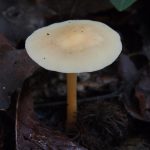
- 3. Collybia aquosa
-
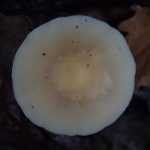
- 3. Collybia aquosa
-
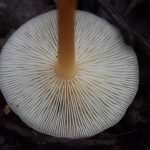
- 3. Collybia aquosa
-
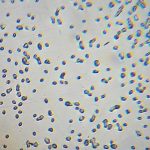
- 3. Collybia aquosa
Growing in leaf litter under oak and holly. A few scattered widely. Cap 4cm. Stem 5cm. ID is almost sure. Sporeprint White. Spores 4-5µ x 3-4µ.
4.
Frosty Bonnet (
Mycena adscendens).
-
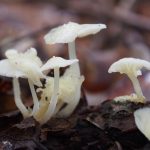
- 4. Frosty Bonnet
-
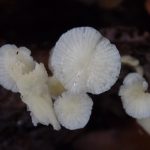
- 4. Frosty Bonnet
-
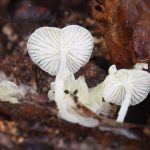
- 4. Frosty Bonnet
-
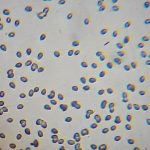
- 4. Frosty Bonnet
Growing on decaying stick. A few small clusters. Cap up to 2cm. Stem up to 5cm. Slight indistinct smell. ID is almost sure. Sporeprint White. Spores 6.5-8.5µ x 5-6µ.
5.
Giant Funnel (
Leucopaxillus giganteus).
-
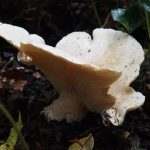
- 5. Giant Funnel
-
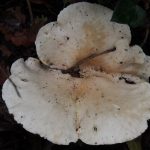
- 5. Giant Funnel
-
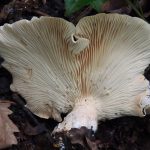
- 5. Giant Funnel
-
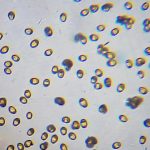
- 5. Giant Funnel
Growing through leaf litter in broad leaf woods. One. Cap 20cm. Stem 5cm long, 3-5cm thick. Mild fragrant mushroom smell. The Giant Funnels that I found last year were growing in pasture so it was a surprise to find one in the woods but the books say it does appear there sometimes. Sporeprint White. Spores 5-6.5µ x 4.5-5.5µ.
6.
Yellow Fieldcap (
Bolbitius titubans).
-
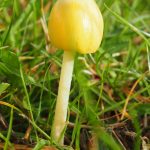
- 6. Yellow Fieldcap
-
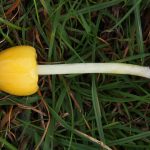
- 6. Yellow Fieldcap
-
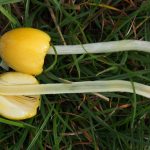
- 6. Yellow Fieldcap
-
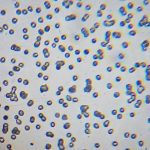
- 6. Yellow Fieldcap
Growing in pasture. Small group of three. Young unopened cap 0.8-2cm. Stem up to 6cm. Smell faint and indistinct. These were young specimens and don't look much like the book picture but there's plenty of online photos similar to mine. Sporeprint Reddish brown. Spores 8.5-11µ x 7-8µ.
7.
Firerug Inkcap (
Coprinellus domesticus).
-
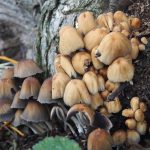
- 7. Firerug Inkcap
-
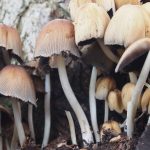
- 7. Firerug Inkcap
-
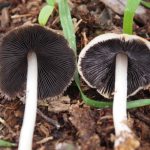
- 7. Firerug Inkcap
-
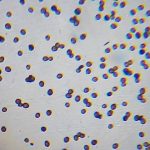
- 7. Firerug Inkcap
Growing on rotting willow stump. Large clusters. Cap up to 5cm. Stem up to 9cm. Smell very faint and indistinct. This inkcap isn't usually in such large clusters but the small spore size means it can't be a similar looking one such as Glistening Inkcap or Coprinellus deliquescens. ID is very likely. Sporeprint Black. Spores 5.5-7.5µ x 4.5-6µ.




























